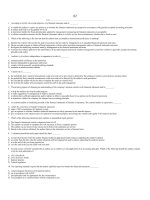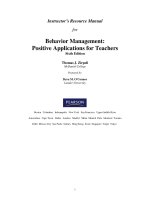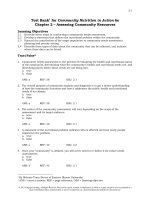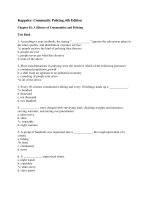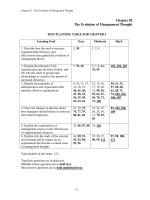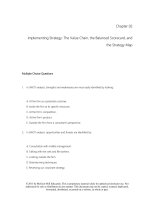Marketing management an asian perspective 6th edition kotler test bank
Bạn đang xem bản rút gọn của tài liệu. Xem và tải ngay bản đầy đủ của tài liệu tại đây (279.14 KB, 36 trang )
Marketing Management – An Asian Perspective, 6th Edition
Chapter 2 Developing Marketing Strategies and Plans
1) The task of any business is to ________.
A) create customer needs
B) differentiate in terms of cost of production
C) deliver customer value at a profit
D) reduce competition
E) communicate similar value as provided by competitors
Answer: C
Page Ref: 40
Objective: 1
Difficulty: Easy
2) What is the traditional view of marketing?
A) Firms should just focus on production because if the products are good then they will
automatically sell.
B) Firms should just focus on making something and then selling it.
C) Firms should have a proper marketing team that can increase consumers' awareness of their
products and rouse their interest in them.
D) Firms should price their products as low as possible so that marketing them becomes easy.
E) Firms should remember that promotion is the most important of the four Ps.
Answer: B
Page Ref: 40
Objective: 1
Difficulty: Easy
3) Value delivery process can be divided into three phases, out of which "choosing the value"
implies _______, which is the essence of strategic marketing.
A) segmentation, developing, and delivering
B) targeting, positioning, and communicating
C) targeting, positioning, and delivering
D) segmentation, targeting, and positioning
E) researching, developing, and delivering
Answer: D
Page Ref: 40
Objective: 1
AACSB: Reflective thinking
Difficulty: Easy
1
Copyright © Pearson Education South Asia Pte Ltd 2013
4) AsiaCorp is one of the best in its industry in terms of costs and performance. Many companies
in its industry will probably consider AsiaCorp as a ________.
A) pioneer
B) benchmark
C) target for acquisition
D) future supplier
E) sounding board for ideas
Answer: B
Page Ref: 41
Objective: 1
AACSB: Reflective thinking
Difficulty: Easy
5) James Foo has been put in charge of gathering marketing intelligence, disseminating it within
his organization, and eventually directing action on the information. Mr. Foo's task is best
described as part of the ________.
A) market-sensing process
B) new-offering realization process
C) customer acquisition process
D) customer relationship management process
E) fulfillment management process
Answer: A
Page Ref: 41
Objective: 1
AACSB: Analytic skills
Difficulty: Moderate
6) When a customer places an order at BookBox.com, the company processes the customer's
payment information, sends the order to the nearest warehouse, and ships the order via FedEx.
This is best described as the ________.
A) market-sensing process
B) customer acquisition process
C) customer relationship management process
D) fulfillment management process
E) new-offering realization process
Answer: D
Page Ref: 41
Objective: 1
AACSB: Analytic skills
Difficulty: Moderate
2
Copyright © Pearson Education South Asia Pte Ltd 2013
7) Today, the "mass market" is actually splintering into numerous segments, each with its own
wants, perceptions, preferences, and buying criteria. This implies that ________.
A) the traditional marketing approach would be the best approach to follow
B) the producers must consider themselves as a part of the value-chain process
C) the producers should focus on niche markets
D) all market segments are equally profitable
E) target market strategies are no longer effective
Answer: B
Page Ref: 40
Objective: 1
AACSB: Analytic skills
Difficulty: Moderate
8) The first phase of the value creation and delivery sequence is ________ that represents the
"homework" marketing must do before any product exists.
A) choosing the value
B) providing the value
C) communicating the value
D) considering the value
E) acquiring the value
Answer: A
Page Ref: 40
Objective: 1
Difficulty: Easy
9) The last step in the value creation and delivery sequence is ________ the value where the
sales force, sales promotion, advertising, and other communication tools announce and promote
the product.
A) developing
B) positioning
C) communicating
D) reversing
E) researching
Answer: C
Page Ref: 40
Objective: 1
Difficulty: Easy
3
Copyright © Pearson Education South Asia Pte Ltd 2013
10) In the cycle of complete strategic planning, taking corrective action is a part of ________.
A) planning
B) implementation
C) controlling
D) organizing
E) analyzing
Answer: C
Page Ref: 46
Objective: 2
AACSB: Analytic skills
Difficulty: Moderate
11) The ________ in the value chain cover the sequence of bringing materials into the business
(inbound logistics), converting them into final products (operations), shipping out final products
(outbound logistics), marketing them (marketing and sales), and servicing them (service).
A) operations processes
B) manufacturing processes
C) primary activities
D) secondary activities
E) tertiary activities
Answer: C
Page Ref: 41
Objective: 1
Difficulty: Easy
12) Michael Porter's value chain would identify which of the following as a support activity?
A) shipping out final products
B) marketing products
C) procurement
D) servicing products
E) operations
Answer: C
Page Ref: 41
Objective: 1
AACSB: Analytic skills
Difficulty: Easy
4
Copyright © Pearson Education South Asia Pte Ltd 2013
13) Which of the following can be considered a primary activity in the value chain process?
A) procurement
B) human resource management
C) technology development
D) inbound logistics
E) firm infrastructure
Answer: D
Page Ref: 41
Objective: 1
AACSB: Analytic skills
Difficulty: Easy
14) The fulfillment management process includes all the activities in ________.
A) gathering and acting upon information about the market
B) researching, developing, and launching new high-quality offerings quickly and within budget
standards
C) defining target markets and prospecting for new customers
D) building deeper understanding, relationships, and offerings to individual customers
E) receiving and approving orders, shipping the goods on time, and collecting payment
Answer: E
Page Ref: 41
Objective: 1
AACSB: Reflective thinking
Difficulty: Moderate
15) With respect to core business processes, the ________ includes all the activities involved in
gathering market intelligence, disseminating it within the organization, and acting on the
information.
A) market-sensing process
B) market research process
C) target marketing process
D) market pulse process
E) deployment process
Answer: A
Page Ref: 41
Objective: 1
AACSB: Analytic skills
Difficulty: Easy
5
Copyright © Pearson Education South Asia Pte Ltd 2013
16) With respect to the core business processes, the ________ includes all the activities involved
in developing, and launching high-quality products quickly and within budget.
A) market-sensing process
B) new-offering realization process
C) fulfillment management process
D) customer acquisition process
E) customer relationship management process
Answer: B
Page Ref: 41
Objective: 1
AACSB: Analytic skills
Difficulty: Easy
17) Activities involved in building deeper understanding of existing consumers and what the
product offerings mean to them would be a part of ________.
A) customer acquisition process
B) customer relationship management process
C) customer prospecting process
D) customer integrating management process
E) customer equity process
Answer: B
Page Ref: 41
Objective: 1
AACSB: Reflective thinking
Difficulty: Moderate
18) ________ allows the company to discover who its target markets are, how they behave, and
what they need or want. It also enables the company to respond appropriately, coherently, and
quickly to different customer opportunities.
A) Network management
B) Supply chain management
C) Marketing management
D) Customer relationship management
E) Total quality management
Answer: D
Page Ref: 41
Objective: 1
Difficulty: Easy
6
Copyright © Pearson Education South Asia Pte Ltd 2013
19) Another way to describe a supply chain, where companies partner with specific suppliers and
distributors to ensure a smooth functioning of the system, is to call it a ________.
A) teamwork group
B) horizontal integration
C) domestic power center
D) value exploration
E) value delivery network
Answer: E
Page Ref: 41
Objective: 1
Difficulty: Easy
20) The key to utilizing organizational core competencies is to ________ that make up the
essence of the business.
A) force organizational departments to justify the budgetary components
B) vertically integrate and own all intermediaries
C) own and nurture the resources and competencies
D) emphasize global promotions
E) segment the workforces
Answer: C
Page Ref: 42
Objective: 1
AACSB: Reflective thinking
Difficulty: Easy
21) ________ has three characteristics: (1) it is a source of competitive advantage in that it
makes a significant contribution to perceived customer benefits; (2) it has applications in a wide
variety of markets; and (3) it is difficult for competitors to imitate.
A) Core competency
B) Market sensing process
C) Corporate social responsibility
D) Strategic business unit
E) Philanthropy
Answer: A
Page Ref: 42
Objective: 1
AACSB: Analytic skills
Difficulty: Moderate
7
Copyright © Pearson Education South Asia Pte Ltd 2013
22) Core competencies tend to refer to areas of special technical and production expertise,
whereas ________ tend to describe excellence in broader business processes.
A) process benchmarks
B) distinctive capabilities
C) distributive capabilities
D) facultative benchmarks
E) concentric capabilities
Answer: B
Page Ref: 42
Objective: 1
Difficulty: Easy
23) Holistic marketers achieve profitable growth by expanding customer share, ________, and
capturing customer lifetime value.
A) undermining competitive competencies
B) building customer loyalty
C) creating customer needs
D) renewing a customer base
E) cannibalizing products
Answer: B
Page Ref: 44
Objective: 1
AACSB: Analytic skills
Difficulty: Easy
24) The holistic marketing framework is designed to address three key management questions.
Which of the following is one of those questions?
A) Value claims—how does the company deal with value clutter?
B) Value proposition—how can value propositions be made profitable?
C) Value erosion—are there weak links in the company's value chain?
D) Value network—how can a company effectively network?
E) Value exploration—how can a company identify new value opportunities?
Answer: E
Page Ref: 45
Objective: 1
AACSB: Analytic skills
Difficulty: Moderate
8
Copyright © Pearson Education South Asia Pte Ltd 2013
25) As Kodak addresses the digital revolution taking over the photographic industry, it wants
customers to see it as a leader in digital photography. Thus, it is moving away from the
production of film roll cameras. This would be an example of which of the following value
creation steps?
A) abandoning current product lines
B) changing the corporate vision
C) repositioning the company's brand identity
D) redoing the corporate logo
E) realigning core competencies
Answer: C
Page Ref: 42
Objective: 1
AACSB: Analytic skills
Difficulty: Moderate
26) Of the four organizational levels, the corporate level is likely to take which of the following
decisions?
A) entering a new market
B) resource allocation for each product
C) strategic plan for individual business units
D) choosing specific suppliers for each business unit
E) marketing plan for each product
Answer: A
Page Ref: 45
Objective: 2
AACSB: Analytic skills
Difficulty: Moderate
27) Most large companies consist of four organizational levels: the corporate level, the
________, the business unit level, and the product level.
A) board of director level
B) major stakeholder level
C) management team level
D) division level
E) strategic level
Answer: D
Page Ref: 45
Objective: 2
AACSB: Analytic skills
Difficulty: Easy
9
Copyright © Pearson Education South Asia Pte Ltd 2013
28) During Jill's market research study, many customers indicated that traditional oven gloves
made it very difficult to hold baking dishes, resulting in frequent spills. Jill brought her findings
to the research department, and her company leveraged its engineering and design competencies
to develop a new hand-held hot-pad that allows for significantly greater dexterity in handling hot
cooking implements, while protecting the cook from burns. This is an example of the ________
element of the holistic marketing framework.
A) integrated marketing
B) value creation
C) negative demand
D) value networking
E) value focus
Answer: B
Page Ref: 44-45
Objective: 2
AACSB: Analytic skills
Difficulty: Moderate
29) The marketing plan, the central instrument for directing and coordinating the marketing
effort, operates at ________ levels.
A) functional and operational
B) strategic and tactical
C) corporate and operational
D) customer and expenditure
E) corporate and division
Answer: B
Page Ref: 45
Objective: 2
AACSB: Analytic skills
Difficulty: Easy
30) The ________ lays out the target markets and the value proposition that will be offered,
based on an analysis of the best market opportunities.
A) organizational plan
B) strategic marketing plan
C) corporate tactical plan
D) corporate mission
E) customer-value statement
Answer: B
Page Ref: 45
Objective: 2
Difficulty: Moderate
10
Copyright © Pearson Education South Asia Pte Ltd 2013
31) Which of the following plans would most likely specify the marketing tactics, including
product features, promotion, merchandising, pricing, sales channels, and service?
A) the tactical marketing plan
B) the target marketing plan
C) the deployment plan
D) the product-launch plan
E) the product-development plan
Answer: A
Page Ref: 45
Objective: 2
AACSB: Analytic skills
Difficulty: Easy
32) Which of the following is NOT one of the four planning activities undertaken by all
corporate headquarters?
A) defining the corporate mission
B) establishing strategic business units
C) assigning resources to each SBU
D) assessing growth opportunities
E) deciding sales channels
Answer: E
Page Ref: 46
Objective: 2
Difficulty: Easy
33) Joe Gan plans the daily promotional releases about his company's products and services. He
can be described as a(n) ________ planner.
A) strategic
B) selective
C) tactical
D) niche
E) operational
Answer: C
Page Ref: 45
Objective: 2
AACSB: Analytic skills
Difficulty: Easy
11
Copyright © Pearson Education South Asia Pte Ltd 2013
34) A clear, thoughtful mission statement provides employees with a shared sense of purpose,
direction, and ________.
A) profitability
B) target market feasibility
C) opportunity
D) continuous improvement
E) quality products
Answer: C
Page Ref: 46
Objective: 2
AACSB: Reflective thinking
Difficulty: Moderate
35) Mission statements are at their best when they reflect a ________.
A) market
B) strength
C) competency
D) vision
E) value
Answer: D
Page Ref: 46
Objective: 2
AACSB: Reflective thinking
Difficulty: Moderate
36) Which of the following is one of the five major characteristics of good mission statements?
A) They focus on a large number of goals.
B) They expand the range of individual employee discretion.
C) They define the major competitive spheres within which the company will operate.
D) They take a short-term view.
E) They are long and comprehensive to ensure that all critical concepts are included.
Answer: C
Page Ref: 46
Objective: 2
AACSB: Reflective thinking
Difficulty: Easy
12
Copyright © Pearson Education South Asia Pte Ltd 2013
37) The ________ is the number of channel levels, from raw materials to final product and
distribution, in which a company will participate.
A) industry sphere
B) vertical sphere
C) product/application sphere
D) competence sphere
E) market segment sphere
Answer: B
Page Ref: 47
Objective: 2
AACSB: Analytic skills
Difficulty: Easy
38) Gerber primarily serves the baby food market. In choosing to focus on this market, Gerber is
defining its competitive sphere on the basis of ________.
A) vertical segmentation
B) backward integration
C) market segmentation
D) diversification
E) differentiation
Answer: C
Page Ref: 47
Objective: 2
AACSB: Analytic skills
Difficulty: Easy
39) While viewing businesses in terms of customer needs can suggest additional growth
opportunities, a ________ tends to focus on selling a product or service to a current market.
A) strategic market definition
B) target market definition
C) cognitive definition
D) product definition
E) tactical definition
Answer: B
Page Ref: 48
Objective: 2
Difficulty: Easy
13
Copyright © Pearson Education South Asia Pte Ltd 2013
40) What are hollow corporations?
A) companies that market their products through franchisees
B) companies that have liabilities exceeding their assets
C) companies that outsource all production to suppliers
D) companies that do not have any physical presence and only operate online
E) companies that are horizontally integrated
Answer: C
Page Ref: 47
Objective: 2
Difficulty: Easy
41) A ________ tends to focus on selling a product or service.
A) target market definition
B) strategic market definition
C) mass-market definition
D) differentiated market definition
E) integrated market definition
Answer: A
Page Ref: 48
Objective: 2
AACSB: Analytic skills
Difficulty: Moderate
42) A business can be defined in terms of three dimensions: customer groups, customer needs
and ___________.
A) size
B) technology
C) competitors
D) services
E) products
Answer: B
Page Ref: 48
Objective: 2
Difficulty: Easy
43) A characteristic of a ________ is that it can be a single business or collection of related
businesses that can be planned separately from the rest of the company.
A) strategic business unit
B) subsidiary unit
C) merged unit
D) niche market unit
E) specialized business unit
Answer: A
Page Ref: 49
Objective: 2
Difficulty: Moderate
14
Copyright © Pearson Education South Asia Pte Ltd 2013
44) A strategic-planning gap can be corrected by ________.
A) changing the company's mission
B) adjusting its core values
C) choosing integrative growth strategies
D) redefining organizational culture
E) increasing resource use
Answer: C
Page Ref: 50, 52
Objective: 2
AACSB: Analytic skills
Difficulty: Easy
45) Market-penetration, product-development, and market-development strategies would all be
examples of ________ strategies.
A) concentric growth
B) conglomerate
C) horizontal
D) intensive growth
E) integrative growth
Answer: D
Page Ref: 50-52
Objective: 2
AACSB: Analytic skills
Difficulty: Moderate
46) Which of the following is an example of growth by diversification?
A) a company introducing its existing products in a new market
B) a company introducing new product category in a new market
C) a company increases its product line in an existing market
D) a company introducing a new product category in an existing market
E) a company integrates backward to cut costs
Answer: B
Page Ref: 52
Objective: 2
Difficulty: Moderate
15
Copyright © Pearson Education South Asia Pte Ltd 2013
47) A company that seeks to increase its sales and profits through backward, forward, or
horizontal integration within the industry is said to be employing a(n) ________ strategy.
A) diversification growth
B) intensive growth
C) target growth
D) integrative growth
E) conglomerate growth
Answer: D
Page Ref: 52
Objective: 2
AACSB: Analytic skills
Difficulty: Moderate
48) Which of the following is an example of integrative growth?
A) a company improves its market share with its current products in the current markets
B) a company enters a new market with current products
C) a company develops new products for its existing markets
D) a company improving sales by integrating backward
E) a company developing new products for new markets
Answer: D
Page Ref: 52
Objective: 2
AACSB: Reflective thinking
Difficulty: Moderate
49) If you were the CEO of a company that was looking to implement strategies to fill a
perceived strategic-planning gap, you would most likely explore ________ strategy first because
it is easier to improve an existing business than to build a new one.
A) market-penetration
B) market-development
C) diversification
D) product-development
E) exclusive
Answer: A
Page Ref: 50
Objective: 2
AACSB: Analytic skills
Difficulty: Moderate
16
Copyright © Pearson Education South Asia Pte Ltd 2013
50) Once Starbucks had established its presence in thousands of cities internationally, the
company sought to increase the number of purchases by existing customers with a ________
strategy that led to new in-store merchandise, including compilation CDs and high-speed
wireless access.
A) product-development
B) market-penetration
C) diversification
D) market-development
E) conglomerate
Answer: A
Page Ref: 50
Objective: 2
AACSB: Analytic skills
Difficulty: Moderate
51) Qantas, the Australian national carrier, introduces flights to the Middle East. This is an
example of ________.
A) product development
B) diversification
C) market development
D) market penetration
E) differentiation
Answer: C
Page Ref: 50
Objective: 2
AACSB: Analytic skills
Difficulty: Moderate
52) A(n) ________ is when a company might seek new businesses that have no relationship to its
current technology, products, or markets.
A) concentric strategy
B) conglomerate strategy
C) horizontal strategy
D) intensive growth strategy
E) integrative strategy
Answer: B
Page Ref: 52
Objective: 2
Difficulty: Moderate
17
Copyright © Pearson Education South Asia Pte Ltd 2013
53) Which of the following terms can be defined as “the shared experiences, stories, beliefs, and
norms that characterize an organization”?
A) organizational dynamics
B) a business mission
C) an ethical/value statement
D) customer relationships
E) corporate culture
Answer: E
Page Ref: 53
Objective: 2
AACSB: Analytic skills
Difficulty: Easy
54) A company’s organization consists of its structures, policies, and corporate culture, all of
which can become dysfunctional in a _______________ business environment.
A) competitive
B) global
C) rapidly changing
D) stagnant
E) local
Answer: C
Page Ref: 53
Objective: 2
Difficulty: Easy
55) The first step in the business unit strategic-planning process deals with which of the
following?
A) formulate goals
B) define business mission
C) implement strategies
D) execute programs
E) conduct SWOT analysis
Answer: B
Page Ref: 57
Objective: 2
Difficulty: Easy
18
Copyright © Pearson Education South Asia Pte Ltd 2013
56) Through its inventory management technology and highly efficient shipping practices, IKEA
is able to keep its inventory expenditure extremely low and to pass these savings on to
consumers in the form of low prices. IKEA's strategy is best described as ________.
A) a focused approach
B) integrative growth
C) differentiation
D) market development
E) overall cost leadership
Answer: E
Page Ref: 61-62
Objective: 2
AACSB: Analytic skills
Difficulty: Moderate
57) When a firm aims to underprice competitors and win market share, it is using a(n) ________
strategy that requires relatively less marketing skills as compared to other strategies.
A) product differentiation
B) overall cost leadership
C) focus
D) domestic customer relationship
E) price skimming
Answer: B
Page Ref: 61-62
Objective: 2
AACSB: Reflective thinking
Difficulty: Easy
58) After analyzing their company's strengths and weaknesses, top managers at Asia Loans
decided to meet the needs of the DINK (dual income, no kids) market segment, Asia Loans
simplified its sales contract, restructured its advertising efforts to focus on Google ads, and
created a separate customer-service department. Asia Loans’ strategy is best described as a(n)
________ strategy.
A) overall cost leadership
B) focus
C) differentiation
D) diversification
E) promotional
Answer: B
Page Ref: 62
Objective: 2
AACSB: Analytic skills
Difficulty: Moderate
19
Copyright © Pearson Education South Asia Pte Ltd 2013
59) Unlike its competitors in the online air travel industry, Travel.com provides its customers
with a greater variety of services such as cruise reservations, package tours, hotel bookings, and
car rentals. This is an example of a(n) ________ strategy.
A) overall cost leadership
B) focus
C) differentiation
D) diversification
E) promotional
Answer: C
Page Ref: 62
Objective: 2
AACSB: Analytic skills
Difficulty: Moderate
60) Microsoft features Pepsi in its XBox 360 games. The best description of this form of alliance
would be a(n) ________.
A) product alliance
B) logistics alliance
C) pricing collaboration
D) network alliance
E) promotional alliance
Answer: E
Page Ref: 62
Objective: 2
AACSB: Analytic skills
Difficulty: Easy
61) Hong Kong’s Li & Fung manages Avon’s supply chain. The best description of this form of
alliance would be a(n) ________.
A) product alliance
B) logistics alliance
C) pricing collaboration
D) indirect collaboration
E) promotional alliance
Answer: B
Page Ref: 62
Objective: 2
AACSB: Analytic skills
Difficulty: Moderate
20
Copyright © Pearson Education South Asia Pte Ltd 2013
62) In India, Pepsi built strategic alliances with Adidas and Microsoft to tap Indian cricket fans
during the World Cup. The best description of this form of alliance would be a ________.
A) product alliance
B) logistics alliance
C) pricing collaboration
D) network alliance
E) promotional alliance
Answer: E
Page Ref: 62
Objective: 2
AACSB: Analytic skills
Difficulty: Moderate
63) When a business gets to know market segments intimately and pursues either cost leadership
or differentiation within the target segment, it is employing a ________.
A) defined strategy
B) focused strategy
C) value-added strategy
D) competitive advantage strategy
E) customer-focused strategy
Answer: B
Page Ref: 62
Objective: 2
AACSB: Analytic skills
Difficulty: Moderate
64) When one company licenses another to produce its offerings, or two companies jointly
market their complementary offerings, it is called a ________.
A) pricing collaboration
B) product or service alliance
C) promotional alliance
D) logistics collaboration
E) total quality management
Answer: B
Page Ref: 62
Objective: 2
AACSB: Analytic skills
Difficulty: Easy
21
Copyright © Pearson Education South Asia Pte Ltd 2013
65) To keep their strategic alliances thriving, corporations have begun to develop organizational
structures to support them and have come to view the ability to form and manage strategic
alliances as core skills. This is called ________.
A) value managed partnership
B) decentralized partnership
C) centralized partnership
D) partner relationship management
E) intensive growth management
Answer: D
Page Ref: 63
Objective: 2
AACSB: Analytic skills
Difficulty: Easy
66) Which of the following statements is true of marketing plans?
A) They can be independently developed without worrying about other functional areas.
B) They provide direction and focus for a brand, product, or company.
C) They are usually profit-oriented.
D) They are of limited use to non-profit organizations.
E) They are typically five-year plans and they lay out the strategies required to achieve targets in
those five years.
Answer: B
Page Ref: 66
Objective: 3
Difficulty: Moderate
67) Which of the following elements of a marketing plan permits senior management to grasp
the organization’s main goals and recommendations?
A) the situation analysis
B) the marketing strategy
C) the executive summary
D) the financial projections
E) the short-term targets
Answer: C
Page Ref: 67
Objective: 3
Difficulty: Easy
22
Copyright © Pearson Education South Asia Pte Ltd 2013
68) The most frequently cited shortcomings of current marketing plans, according to marketing
executives, are lack of realism, insufficient competitive analysis, and a ________ focus.
A) long-term
B) profit
C) short-run
D) product
E) price
Answer: C
Page Ref: 66
Objective: 3
Difficulty: Easy
69) The ________ is the last section of the marketing plan and spells out the goals and budget for
each month or quarter, so management can review each period's results and take action as
needed.
A) executive summary
B) situation analysis
C) marketing strategy
D) financial projections
E) implementation and controls
Answer: E
Page Ref: 67
Objective: 3
AACSB: Analytic skills
Difficulty: Easy
70) The traditional view of marketing is that the firm makes something and then sells it.
Answer: TRUE
Page Ref: 40
Objective: 1
AACSB: Reflective thinking
Difficulty: Easy
71) Marketing goods that are currently in short supply would require significant marketing talent.
Answer: FALSE
Page Ref: 57
Objective: 1
AACSB: Reflective thinking
Difficulty: Easy
72) The traditional view of marketing works best in economies with many different types of
people, each with individual wants, perceptions, preferences, and buying criteria.
Answer: FALSE
Page Ref: 40
Objective: 1
Difficulty: Easy
23
Copyright © Pearson Education South Asia Pte Ltd 2013
73) In the communication stage of the value creation and delivery sequence, marketing must
determine specific product features, prices, and distribution channels.
Answer: FALSE
Page Ref: 40
Objective: 1
Difficulty: Moderate
74) The customer relationship management process involves all the activities related to receiving
and approving orders, shipping the goods on time, and collecting payment.
Answer: FALSE
Page Ref: 41
Objective: 1
AACSB: Analytic skills
Difficulty: Easy
75) The new-offering realization process involves all activities in defining target markets and
prospecting for new customers.
Answer: FALSE
Page Ref: 41
Objective: 1
AACSB: Analytic skills
Difficulty: Moderate
76) A principle of the value chain is that every firm is a synthesis of activities performed to
design, produce, market, deliver, and support its product.
Answer: TRUE
Page Ref: 41
Objective: 1
Difficulty: Easy
77) Another name for a company's value delivery network is "distribution chain."
Answer: FALSE
Page Ref: 41
Objective: 1
AACSB: Analytic skills
Difficulty: Easy
78) Competitors in a given industry can be identified by the similarities in their core
competencies.
Answer: FALSE
Page Ref: 42
Objective: 1
AACSB: Reflective thinking
Difficulty: Easy
24
Copyright © Pearson Education South Asia Pte Ltd 2013
79) A firm's core competency has applications only in the specific market in which the firm
operates.
Answer: FALSE
Page Ref: 42
Objective: 1
AACSB: Reflective thinking
Difficulty: Moderate
80) Holistic marketing focuses on the integration of value exploration, value creation, and value
delivery as a means to build long-term relationships with consumers.
Answer: TRUE
Page Ref: 44
Objective: 1
Difficulty: Easy
81) When a manager is trying to identify how the company can efficiently create promising new
offerings, he is addressing the question of value delivery.
Answer: FALSE
Page Ref: 45
Objective: 1
AACSB: Reflective thinking
Difficulty: Easy
82) The marketing plan is the central instrument for directing and coordinating the marketing
effort.
Answer: TRUE
Page Ref: 45
Objective: 1
AACSB: Analytic skills
Difficulty: Easy
83) A strategy is a game plan for achieving long-run objectives.
Answer: TRUE
Page Ref: 45
Objective: 2
AACSB: Reflective thinking
Difficulty: Easy
84) Mission statements that express unrealistic visions are usually unable to inspire employees to
achieve their targets.
Answer: FALSE
Page Ref: 46
Objective: 2
Difficulty: Easy
25
Copyright © Pearson Education South Asia Pte Ltd 2013
